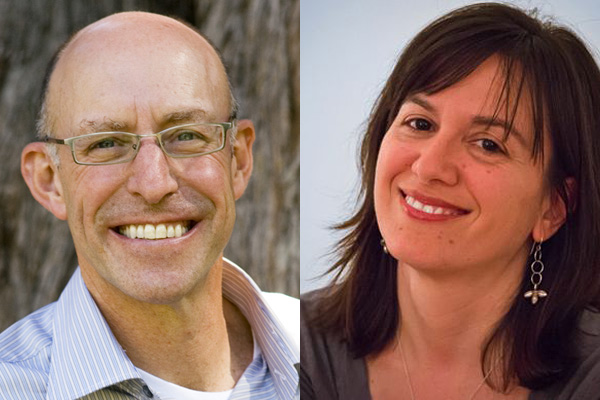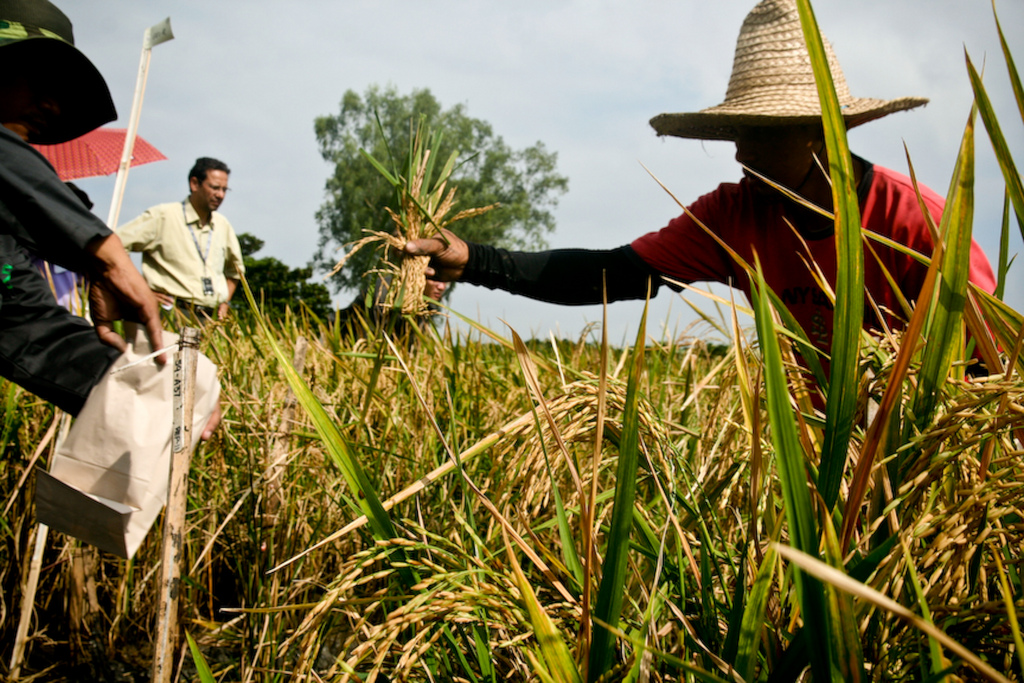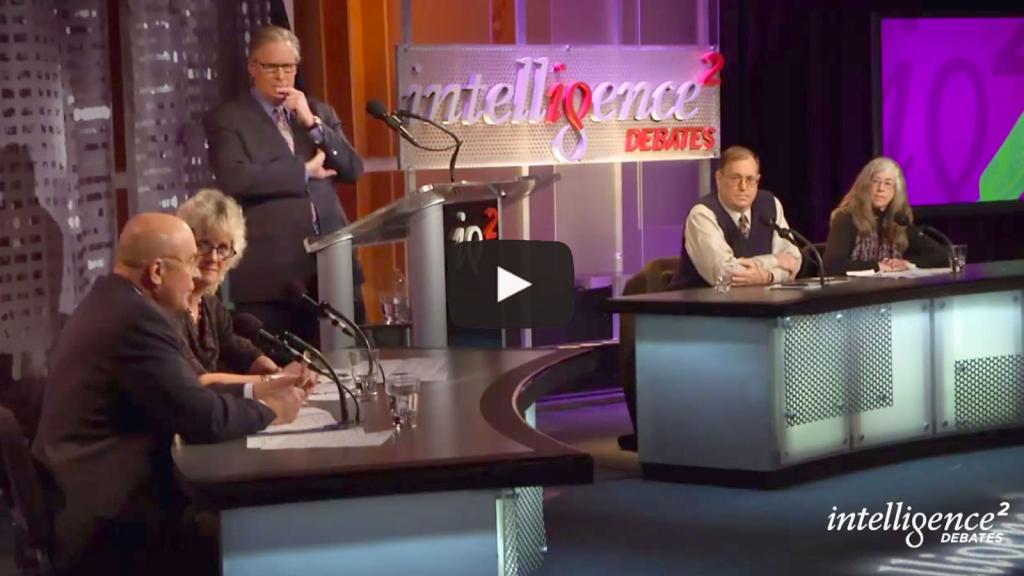
IRRIGolden Rice.
Golden Rice is rice that’s been genetically engineered to deliver enough beta carotene to improve the health of the malnourished poor who might eat it. (Deficiencies blind over 250,000 children a year.) It’s a humanitarian project — funded by the Rockefeller and Gates foundations, among others — that has been in development since the 1990s. Some people object to it; they see it as a Trojan Horse that the biotech industry is using to enter countries that might otherwise reject their technology.
Recently, a group of protesters destroyed a test plot of the rice, turning up the heat on the debate over the crop that’s simmered for years. Amy Harmon wrote this reaction. Mark Lynas went to see the trampled rice for himself and has filed this angry but essential report from the scene. And Michael Pollan weighed in on Andrew Revkin’s Dot Earth blog, saying “I certainly think that the research should go forward.”
Pollan had some caveats, writing, “I am willing to get behind a GM product that offers the world something great, but I’m not at all sure this is the killer app everyone thinks it is. It seems to me the focus should be on alleviating poverty and improving diet.”
Later, Alexander J. Stein, an agricultural economist at the International Food Policy Research Institute, added some truly useful detail, pointing out that there was now research to address some of the issues Pollan raised.
Here’s the 30,000 foot perspective on the history of Golden Rice: A couple of scientists started working on it, and after many frustrating years, realized how difficult the project was. They asked for industry help and Syngenta lent its aid and expertise. The Syngenta scientists had the practical know-how to get over the stumbling blocks, but in that period the industry also used Golden Rice as a PR tool to make the argument for biotech. The argument was a bit strained, because at that point the rice wasn’t actually working, as Pollan wrote in 2001:
Its real achievement may be to win an argument rather than solve a public-health problem. Which means we may be witnessing the advent of the world’s first purely rhetorical technology.
At the time, even former Rockefeller Foundation President Gordon Conway (who is massively respected as a smart and honest broker on this subject, and who was funding the Golden Rice research) said, “The public-relations uses of golden rice have gone too far.”
More than a decade later, a lot has changed. The television ads using Golden Rice as an argument for the biotech industry have stopped. And now, if governments approve (and the rice is really ready — after so many delays I’ll believe it only when it happens), low income farmers can start using the rice for free. It will be really interesting to see if it works.
The other night I was talking with Richard Jefferson, an open source biologist and deep thinker who runs an independent lab bent on democratizing and decentralizing science. Jefferson was brought on board to help with Golden Rice for a period, and he isn’t afraid to speak bluntly. So I asked him, was Golden Rice a solution in search of a problem? In other words, did the engineers start by saying, “How can we use GM technology for something cool?” rather than saying, “Let’s tackle this malnutrition problem. What’s the best tool for that?”
Absolutely not, Jefferson said. The people behind Golden Rice have kept funding it because it might just work in a way that nothing else can, he said. It’s easy enough to point to other potential solutions, but those solutions all come with downsides as well, and they haven’t righted the problem.
“The guys who developed it did it for the right reasons,” Jefferson said. “They really were outraged by micronutrient deficiencies. They were out there in the rice paddies and in the villages. Every one of the Rockfeller Foundation meetings was in the developing world, and we were out there, learning things with these people.”
It’s true though, he said, that the biotech industry started using Golden Rice as a public relations tool. But we shouldn’t dismiss this technology because the wrong people have deployed it as an argument. “Golden Rice got turned into both a poster child and a whipping boy. The activists say, ‘It’s just a cat’s paw for Syngenta!’ and by that time the institutions were starting to use it that way. So unfortunately kids who are going blind get caught in the crossfire.”
Perhaps the problem with Golden Rice, as Marion Nestle has pointed out, is that it’s indicative of an assumption that “complex societal problems — in this case, malnutrition — are more easily solved by private-sector, commercially driven science than by societal decisions and political actions.”
There’s a good point there: Social problems usually require social solutions — messy and hard as they are. But the thing is, sometimes technology really can help.
Here’s my take on Golden Rice: It’s one small, flawed fix for the massive problem of malnutrition in Asia. It’s probably not going to be the fix, but it seems shortsighted to attack the people who are actually on the ground trying to do good, unless you are out there too with something much better.
Are there other fixes? Yep, you could give people pills, or convince them to grow (and eat) more vegetables. But the donors supporting Golden Rice have been trying that too. The hope is that Golden Rice can put a little more of a dent in the problem. At the very least, as Pollan put it, after all these years of promises, it will be interesting to watch this test case: “We deserve to find out once and for all if this shining promise can live up to the hype.”
Sure, Golden Rice has been used for biotech industry PR, and if it succeeds we’ll doubtless see more of that. But it also holds potential for real good.
More in this series:
- The genetically modified food debate: Where do we begin?
- The GM safety dance: What’s rule and what’s real
- Genetic engineering vs. natural breeding: What’s the difference?
- Is nature a cradle or a battlefield?
- Genetically engineered food: Allergic to regulations?
- Genetically modified seed research: What’s locked and what isn’t
- Genetically modified literature (in which I read books so you don’t have to)
- Is extremism in defense of GM food a vice?
- Elephant in the room: Why getting the GMO story straight is so hard
- Food for bots: Distinguishing the novel from the knee-jerk in the GMO debate



